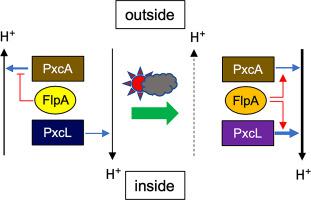Biochimica et Biophysica Acta (BBA) - Bioenergetics ( IF 3.4 ) Pub Date : 2020-06-30 , DOI: 10.1016/j.bbabio.2020.148258 Haruya Inago 1 , Ryoichi Sato 1 , Shinji Masuda 1

|
Upon a dark-to-light transition, multiple species of cyanobacteria release a certain amount of H+ from the inside to the outside of their cells. Previous studies revealed the plasma membrane-localizing Proton exchange A (PxcA) is involved in the light-induced H+ extrusion in the cyanobacterium Synechocystis sp. PCC6803. Among oxygenic phototrophs, two PxcA homologs are conserved; they are the nuclear-encoded Day-length-dependent delayed-greening1 (DLDG1) and the plastid-encoded Ycf10 in Arabidopsis thaliana. We previously identified the putative DLDG1/Ycf10-interacting protein, Fluctuating-light acclimation protein1 (FLAP1), required for pH regulation in Arabidopsis chloroplasts. Synechocystis has PxcA and FLAP1 homologs designated here as PxcA like (PxcL) and FLAP1 homolog A (FlpA). Synechocystis mutants lacking pxcA, pxcL, and flpA were constructed and characterized to gain more insight into regulatory mechanisms of light-induced H+ extrusion in cyanobacteria. pH change kinetics of the extracellular solvent after shifting Synechocystis cells from dark to light indicated that PxcA is essential for the light-induced H+ extrusion, and both PxcA and PxcL were involved in H+ uptake. Mutational loss of flpA resulted in altered PxcA- and PxcL-dependent H+ efflux/influx activities, and the flpA-null mutant showed inhibited growth under dark–light cycles, indicating the importance of FlpA function for photosynthetic growth under fluctuating light. Collectively, these data suggest that PxcA is involved in H+ efflux immediately after light irradiation for the rapid formation of the H+ concentration gradient across the thylakoid membranes, PxcL is involved in H+ influx for activation of the Calvin-Benson-Bassham cycle, and FlpA controls the H+ transport under fluctuating light.
中文翻译:

调节光诱导的H +挤压和质体藻类中质体FLAP1,DLDG1和Ycf10的蓝细菌同源物吸收。PCC6803。
在从暗到亮的过渡过程中,多种蓝细菌从其细胞的内部向外部释放一定量的H +。先前的研究表明质膜本地化质子交换A(PxcA)参与了蓝藻集胞藻(Synechocystcystis sp。)中光诱导的H +挤出。PCC6803。在含氧营养养分中,两个PxcA同源物是保守的。它们是拟南芥中核编码的依赖天长的延迟绿化1(DLDG1)和质体编码的Ycf10 。我们之前确定了拟南芥叶绿体中调节pH所需的假定的DLDG1 / Ycf10相互作用蛋白,起伏驯化蛋白1(FLAP1)。突囊藻具有在此称为PxcA(PxcL)和FLAP1同系物A(FlpA)的PxcA和FLAP1同系物。缺乏pxcA,pxcL和flpA的集胞藻突变体的构建和表征可以更深入地了解蓝细菌中光诱导的H +挤出的调控机制。突囊藻细胞从黑暗转移到光亮后,细胞外溶剂的pH改变动力学表明PxcA对于光诱导的H +挤出至关重要,并且PxcA和PxcL均参与了H +的吸收。flpA的突变丢失导致PxcA和PxcL依赖的H +改变外排/流入活动,并且flpA- null突变体在暗光循环下显示出受抑制的生长,表明FlpA功能对于在波动的光下光合生长的重要性。总体而言,这些数据表明,在光照射后,PxcA立即参与了H +的流出,从而在整个类囊体膜上迅速形成了H +浓度梯度; PxcL参与了H +的流入,从而激活了Calvin-Benson-Bassham循环, FlpA在波动的光线下控制H +的传输。











































 京公网安备 11010802027423号
京公网安备 11010802027423号